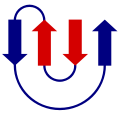Protein topology

Protein topology is a property of protein molecule that does not change under deformation (without cutting or breaking a bond).
Frameworks
[edit]Two main topology frameworks have been developed and applied to protein molecules.
Knot Theory
[edit]Knot theory which categorises chain entanglements. The usage of knot theory is limited to a small percentage of proteins as most of them are unknot.
Circuit topology
[edit]Circuit topology categorises intra-chain contacts based on their arrangements. Circuit topology is a determinant of protein folding kinetics[1] and stability.[2]
Other Uses
[edit]In biology literature, the term topology is also used to refer to mutual orientation of regular secondary structures, such as alpha-helices and beta strands in protein structure[3] [1]. For example, two adjacent interacting alpha-helices or beta-strands can go in the same or in opposite directions. Topology diagrams of different proteins with known three-dimensional structure are provided by PDBsum (an example).
See also
[edit]References
[edit]- ^ B. Scalvini et al., Topological principles of protein folding. Physical Chemistry Chemical Physics 23, 21316-21328 (2021)
- ^ J. Woodard et al., Chain topology predicts pathogenicity of missense mutations. Proteins: Structure, Function, and Bioinformatics 90(9) 1634-1644 (2022)
- ^ Rawlings, C J; Taylor, W R; Nyakairu, J; Fox, J; Sternberg, M J.E. (1985). "Reasoning about protein topology using the logic programming language PROLOG". Journal of Molecular Graphics. 3 (4): 151–157. doi:10.1016/0263-7855(85)80027-8.
External links
[edit]


 French
French Deutsch
Deutsch